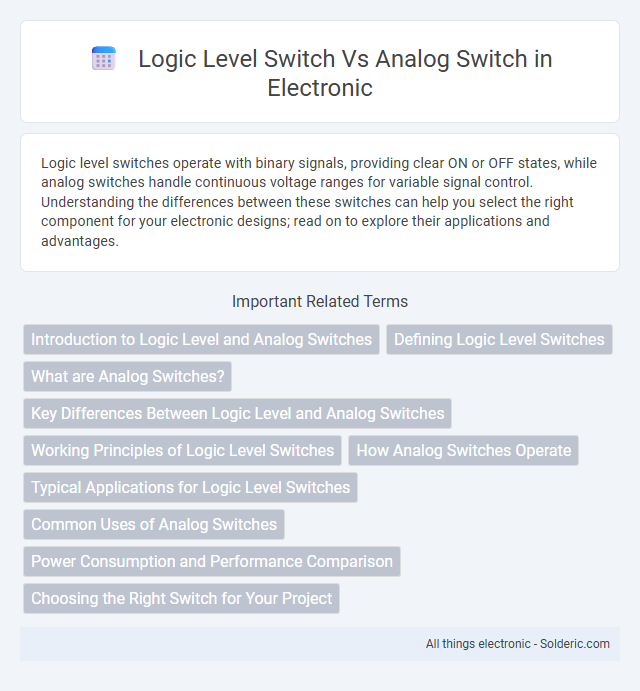Logic level switches operate with binary signals, providing clear ON or OFF states, while analog switches handle continuous voltage ranges for variable signal control. Understanding the differences between these switches can help you select the right component for your electronic designs; read on to explore their applications and advantages.
Comparison Table
| Feature | Logic Level Switch | Analog Switch |
|---|---|---|
| Function | Switches digital signals based on logic levels (high/low) | Switches analog signals without digitizing |
| Signal Type | Digital | Analog |
| On-Resistance | Typically low and constant | Varies with signal and voltage |
| Control Input | Logic voltage (e.g., 0V or 5V) | Control voltage or logic level |
| Applications | Digital circuits, microcontroller interfaces | Audio signal routing, analog multiplexing |
| Signal Distortion | Minimal, for digital pulses | Possible, affects analog fidelity |
| Isolation | High isolation between on/off states | Moderate isolation, leakage possible |
| Speed | Fast switching for digital logic | Moderate, depends on design |
Introduction to Logic Level and Analog Switches
Logic level switches operate by using digital signals to control the on/off state of an electronic circuit, typically translating low-voltage logic signals into switching actions. Analog switches allow continuous signal transmission, enabling the passage of analog or digital signals without distortion, often used in multiplexers and signal routing. Both switches serve critical roles in electronic design, with logic level switches primarily handling discrete signals and analog switches managing variable or continuous signal paths.
Defining Logic Level Switches
Logic level switches are semiconductor devices designed to operate with specific voltage thresholds, allowing digital control signals to enable or disable the switch effectively. These switches interpret logic-level inputs, typically within the range of 0 to 5 volts, to control the flow of current in a circuit. Unlike analog switches, logic level switches emphasize precise switching behavior based on digital logic states, making them ideal for microcontroller and digital system applications.
What are Analog Switches?
Analog switches are semiconductor devices designed to pass or block analog signals without altering their amplitude or waveform, enabling seamless signal routing in electronic circuits. Unlike digital switches that handle discrete logic levels, analog switches manipulate continuous voltage ranges, making them essential for audio, video, and sensor applications. Key features include low on-resistance, minimal distortion, and bidirectional signal flow, ensuring high-fidelity signal transmission.
Key Differences Between Logic Level and Analog Switches
Logic level switches operate with digital signals, using defined voltage thresholds to toggle between on and off states, ensuring precise and fast switching performance in digital circuits. Analog switches handle continuous analog signals, allowing seamless signal transmission without distortion, making them ideal for audio and signal processing applications. Understanding these key differences helps you select the appropriate switch type based on whether your application requires binary control or analog signal handling.
Working Principles of Logic Level Switches
Logic level switches operate by toggling a digital control signal that directly activates or deactivates the switch, enabling efficient on/off states with minimal voltage thresholds. They utilize MOSFET transistors designed to fully turn on at low gate voltages, ensuring rapid response times and low power consumption. This mechanism contrasts with analog switches, which modulate continuous signals without requiring distinct digital logic thresholds.
How Analog Switches Operate
Analog switches operate by controlling the flow of analog signals through a transistor-based switching element, typically MOSFETs, which act as variable resistors when turned on or off by a control voltage. They allow continuous voltage and current to pass with low on-resistance, maintaining signal integrity without converting the signal into digital form. This makes analog switches ideal for multiplexing, routing, and signal gating in audio, video, and instrumentation applications.
Typical Applications for Logic Level Switches
Logic level switches are commonly used in digital circuits to control signal flow with minimal voltage drop, ideal for powering microcontrollers, sensors, and low-voltage devices in battery-operated gadgets or embedded systems. These switches efficiently handle on/off control in logic level environments, making them perfect for interfacing between different voltage domains or enabling/disabling peripherals in consumer electronics and industrial automation. Your design benefits from their fast switching speed and low resistance, ensuring reliable performance in signal routing and power management applications.
Common Uses of Analog Switches
Analog switches are commonly used in signal routing applications, such as audio and video signal multiplexing, where they allow seamless signal passage without distortion. They are essential in data acquisition systems for selecting and isolating different input channels before analog-to-digital conversion. These switches are also widely employed in sample-and-hold circuits and precision measurement equipment due to their low on-resistance and minimal signal leakage.
Power Consumption and Performance Comparison
Logic level switches typically consume less power due to their straightforward ON/OFF operation, making them ideal for low-power applications. Analog switches offer higher performance in terms of signal fidelity and bandwidth, allowing precise control of analog signals with minimal distortion. Your choice depends on whether low power consumption or superior signal integrity is more critical for your design.
Choosing the Right Switch for Your Project
Selecting the right switch depends on signal requirements and control complexity; logic level switches effectively handle digital ON/OFF signals with precise voltage thresholds while analog switches excel in passing continuous analog signals with minimal distortion. Logic level switches integrate well in microcontroller-driven applications requiring clear binary states, whereas analog switches are ideal for audio, video, and sensor signal routing where maintaining signal integrity is crucial. Careful evaluation of voltage range, switching speed, and signal fidelity ensures optimal performance tailored to your project's needs.
logic level switch vs analog switch Infographic

 solderic.com
solderic.com